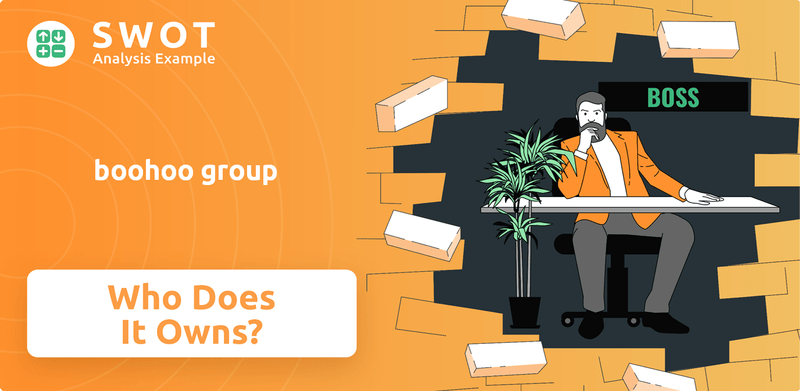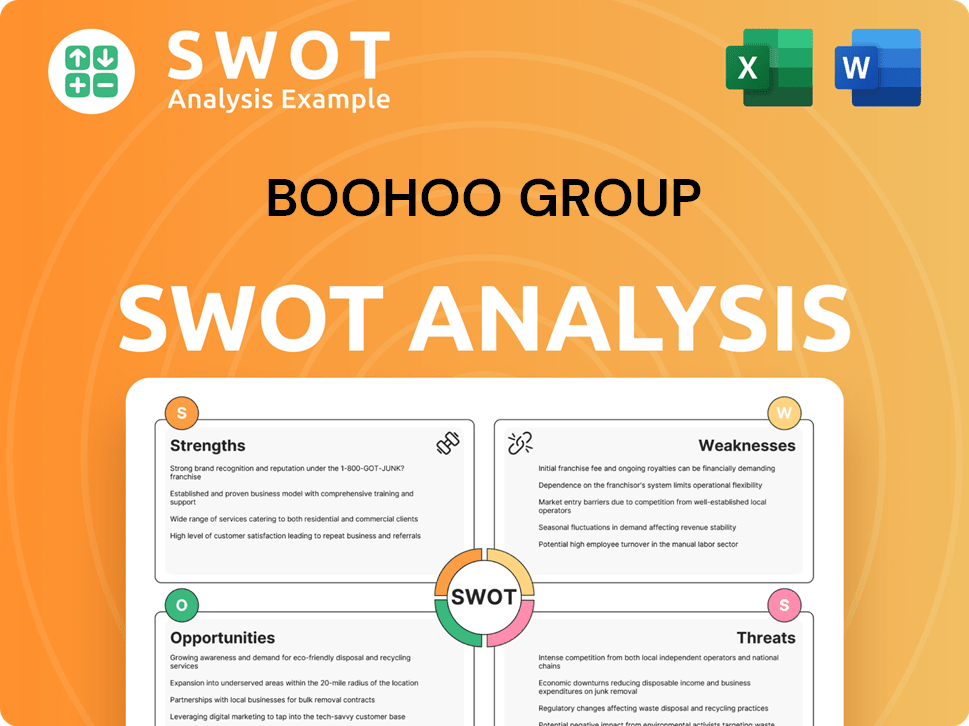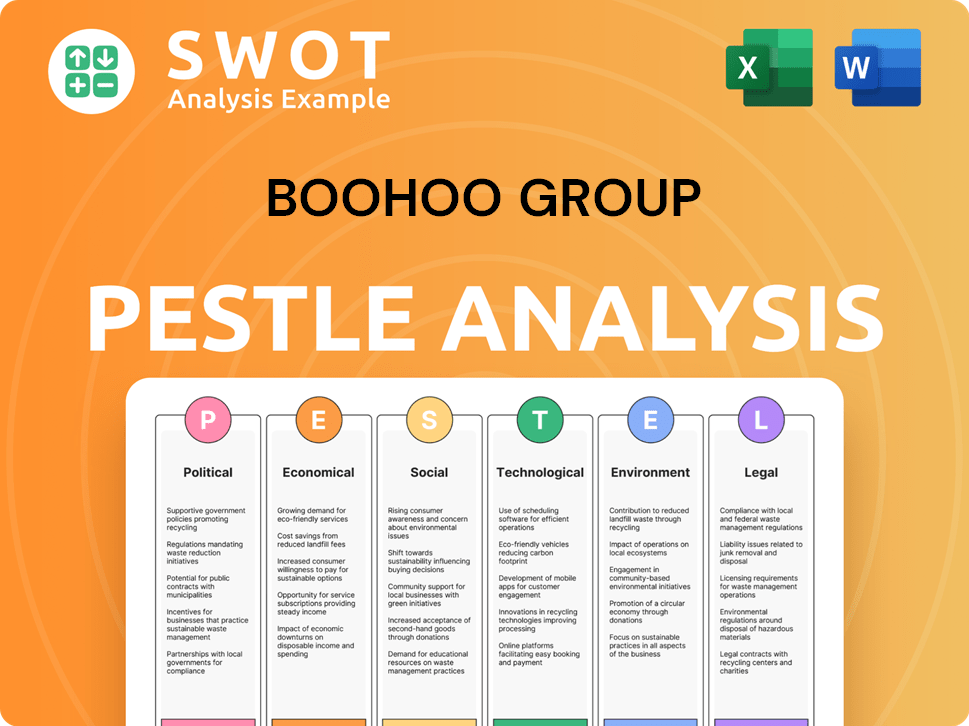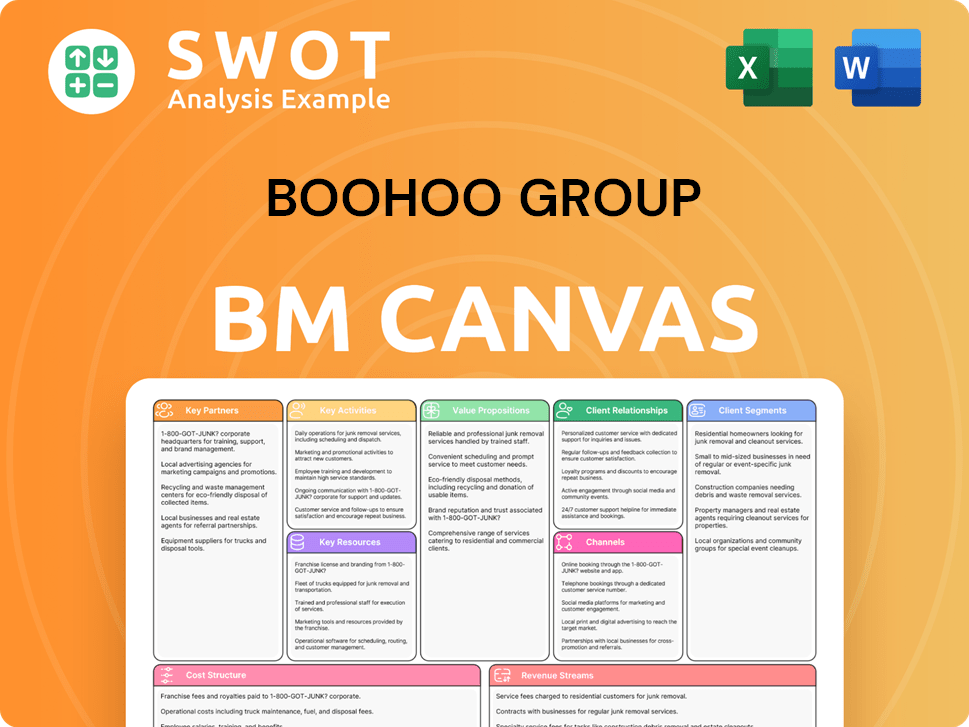boohoo group Bundle
Who Really Owns Boohoo Group PLC?
Ever wondered who calls the shots at one of the UK's biggest online fashion retailers? The ownership structure of a company profoundly impacts its strategy and market performance. From its humble beginnings to its current global footprint, the boohoo group SWOT Analysis reveals a fascinating evolution in its ownership. This article uncovers the intricate details of who owns boohoo, exploring the key players and their influence.

Understanding the boohoo group ownership is crucial for anyone interested in the fast-fashion industry. This examination of the boohoo company's structure, including the boohoo shareholders and major investors, provides insights into its strategic direction. Discover the answers to questions like "who owns boohoo" and "who is the CEO of boohoo," and gain a comprehensive understanding of boohoo plc's corporate structure and the individuals shaping its future. This deep dive into the boohoo group's ownership unveils the forces driving its continued success and market presence.
Who Founded boohoo group?
The boohoo group ownership story begins with its founders, Mahmud Kamani and Carol Kane, who established the company in 2006. Their vision was to create a fast-fashion empire, and their initial control over the company was fundamental to achieving this goal. Understanding who owns boohoo is key to grasping its evolution from a small startup to a global fashion retailer.
At the outset, the ownership of boohoo plc was mainly held by Kamani and Kane. While the exact initial equity split isn't widely available, their combined expertise in textiles and buying, respectively, formed the core of the business. This concentrated ownership structure allowed for quick decision-making and a unified strategic direction, crucial in the rapidly changing fashion industry.
Early financial backing for the boohoo company predominantly came from the founders' personal resources and their immediate network. Unlike some startups that rely on significant venture capital, boohoo initially grew organically. This bootstrap approach, coupled with a direct-to-consumer strategy, allowed the company to maintain control and adapt swiftly to market trends.
Mahmud Kamani and Carol Kane's shared vision drove the company's early success.
The initial funding came primarily from the founders themselves and their close network.
The early ownership was concentrated, enabling agile decision-making.
The founders' direct control and vision were pivotal in the early stages of boohoo group ownership. This structure allowed for rapid adaptation and growth in the competitive fashion market. The founders' commitment and strategic decisions shaped the company's trajectory.
- Kamani and Kane were the primary boohoo owners at the start.
- The company's early growth was fueled by a lean operational model.
- The concentrated ownership facilitated quick strategic decisions.
- The direct-to-consumer approach was a key early strategy.
boohoo group SWOT Analysis
- Complete SWOT Breakdown
- Fully Customizable
- Editable in Excel & Word
- Professional Formatting
- Investor-Ready Format

How Has boohoo group’s Ownership Changed Over Time?
The ownership structure of the boohoo group significantly changed with its Initial Public Offering (IPO) on the London Stock Exchange in March 2014. This transition from a private to a public entity, with an initial market capitalization of approximately £560 million, allowed for a diverse shareholder base. This included institutional investors, mutual funds, and individual public shareholders, marking a pivotal shift in the company's ownership dynamics.
As of late 2024 and early 2025, the ownership of boohoo group (boohoo plc) is a mix of its founders, their families, and major institutional investors. The IPO in 2014 was a key event, transforming the company's ownership structure and attracting a broader investor base. This move was crucial for the company's growth and expansion in the competitive online fashion retail market. The evolution of the company's ownership reflects its journey from a private enterprise to a publicly traded company.
| Shareholder | Percentage of Shares (as of December 31, 2023) | Notes |
|---|---|---|
| Capital Research Global Investors | 13.90% | A significant institutional investor. |
| T. Rowe Price Associates, Inc. | 8.92% | Another major institutional shareholder. |
| BlackRock, Inc. | 5.23% | A key institutional investor. |
The major shareholders in boohoo group include the founders, Mahmud Kamani, and his family, along with institutional investors like Capital Research Global Investors, T. Rowe Price Associates, Inc., and BlackRock, Inc. These institutional investors hold considerable stakes, influencing company strategy through voting rights and engagement with management. For more details on the financial aspects of the company, you can also read about the Revenue Streams & Business Model of boohoo group.
The ownership of boohoo group (boohoo plc) has evolved significantly since its IPO in 2014, with major shareholders including founders and institutional investors.
- Mahmud Kamani and his family hold a substantial stake.
- Capital Research Global Investors, T. Rowe Price Associates, Inc., and BlackRock, Inc. are significant institutional investors.
- The IPO in 2014 was a key event, transforming the company's ownership structure.
- Institutional investors influence company strategy.
boohoo group PESTLE Analysis
- Covers All 6 PESTLE Categories
- No Research Needed – Save Hours of Work
- Built by Experts, Trusted by Consultants
- Instant Download, Ready to Use
- 100% Editable, Fully Customizable

Who Sits on boohoo group’s Board?
The Board of Directors of the boohoo group PLC is central to the company's governance. As of early 2025, the board typically includes executive directors, non-executive directors representing significant shareholders, and independent non-executive directors. The current CEO is John Lyttle, while Mahmud Kamani, co-founder, serves as Group Executive Chairman, showcasing the continued influence of the founders. Carol Kane, the other co-founder, also remains on the board as an Executive Director. This structure reflects a blend of founder representation, major shareholder interests, and independent oversight, influencing the company's strategic direction and operational decisions. The presence of key figures like Lyttle, Kamani, and Kane highlights the leadership's role in steering the company's future, as well as the influence of major investors in the company's direction.
The board's composition and the influence of key stakeholders are crucial for understanding the boohoo group ownership structure and how decisions are made. The board's structure is designed to balance founder influence, major shareholder interests, and independent oversight. This setup is crucial for addressing the complex challenges and opportunities within the fast-paced fashion retail industry. The directors oversee the company's strategic direction and operational performance, making their roles essential for the company's success and its ability to adapt to market changes and stakeholder expectations.
| Director | Position | Notes |
|---|---|---|
| John Lyttle | CEO | Oversees the company's overall operations and strategic direction. |
| Mahmud Kamani | Group Executive Chairman | Co-founder, provides strategic guidance and leadership. |
| Carol Kane | Executive Director | Co-founder, contributes to the company's strategic and operational decisions. |
The voting structure of boohoo group PLC generally follows a one-share-one-vote principle for its ordinary shares. However, the substantial shareholdings of the Kamani family, particularly through entities like JKBM Limited, grant them significant voting power. This allows them to exert considerable influence over key decisions, including board appointments and strategic initiatives. The structure does not include dual-class shares or special voting rights that would grant outsized control beyond direct share ownership. This ownership structure is a key aspect of understanding who owns boohoo and the dynamics within the company. The influence of major shareholders is a critical factor, especially when considering the company's strategic direction and operational decisions. This structure has implications for corporate governance and the balance of power within the company.
The boohoo group ownership structure is influenced by the board of directors and the voting power of major shareholders. The Kamani family, through entities like JKBM Limited, holds significant voting power. This impacts key decisions, including board appointments and strategic initiatives. For more insights, check out the Marketing Strategy of boohoo group.
- The board includes executive directors, non-executive directors, and independent non-executive directors.
- Mahmud Kamani serves as Group Executive Chairman, and John Lyttle is the CEO.
- The voting structure is based on a one-share-one-vote principle.
- The Kamani family's shareholdings grant them significant influence.
boohoo group Business Model Canvas
- Complete 9-Block Business Model Canvas
- Effortlessly Communicate Your Business Strategy
- Investor-Ready BMC Format
- 100% Editable and Customizable
- Clear and Structured Layout

What Recent Changes Have Shaped boohoo group’s Ownership Landscape?
Over the past few years, the ownership structure of boohoo group has shown interesting developments. The Kamani family, who founded the company, continues to hold a significant stake, demonstrating their ongoing commitment. This is a key aspect of understanding who owns boohoo, as their influence remains substantial. This family's continued involvement provides stability, even as the company grows and evolves in the competitive fast-fashion market. For those interested in a deeper dive, a Brief History of boohoo group can offer additional context.
Institutional investors also play a crucial role in boohoo group ownership. Major firms such as Capital Research Global Investors, T. Rowe Price Associates, Inc., and BlackRock, Inc. have consistently been among the top shareholders. The presence of these large institutional investors reflects a trend of increased institutional ownership in well-established public companies. However, shifts in these holdings can occur due to factors like ESG considerations and financial performance within the fast-fashion sector. The company's acquisitions, such as Debenhams and the Arcadia brands, may attract new investors or consolidate existing ones.
| Shareholder | Approximate Percentage Held (as of most recent filings) | Notes |
|---|---|---|
| Mahmud Kamani and Family | Varies, but significant | Founding family, maintains substantial influence |
| Capital Research Global Investors | Varies | Major institutional investor |
| T. Rowe Price Associates, Inc. | Varies | Institutional investor |
| BlackRock, Inc. | Varies | Institutional investor |
The boohoo company has also seen changes in its board of directors, which can influence investor confidence and ownership dynamics. There have been no recent major public statements regarding privatization or significant secondary offerings. This suggests a focus on organic growth and operational improvements within its current public ownership structure.
The primary ownership of boohoo is split between the founding Kamani family and institutional investors. The Kamani family holds a substantial stake, ensuring their continued influence. Major institutional investors include Capital Research Global Investors, T. Rowe Price Associates, Inc., and BlackRock, Inc.
Key shareholders include the founding Kamani family, who is the boohoo owner, and several large institutional investors. These investors often hold significant percentages of the company’s shares. Their decisions can impact the company's direction and stock performance.
Recent trends include the continued influence of the Kamani family and the presence of institutional investors. Acquisitions, such as Debenhams and Arcadia brands, have expanded the company's market share. Leadership changes also reflect an evolving governance structure.
The company appears focused on organic growth and operational improvements. There have been no major public statements regarding privatization or significant secondary offerings. The company's strategic direction is influenced by its ownership structure and market conditions.
boohoo group Porter's Five Forces Analysis
- Covers All 5 Competitive Forces in Detail
- Structured for Consultants, Students, and Founders
- 100% Editable in Microsoft Word & Excel
- Instant Digital Download – Use Immediately
- Compatible with Mac & PC – Fully Unlocked

Related Blogs
- What are Mission Vision & Core Values of boohoo group Company?
- What is Competitive Landscape of boohoo group Company?
- What is Growth Strategy and Future Prospects of boohoo group Company?
- How Does boohoo group Company Work?
- What is Sales and Marketing Strategy of boohoo group Company?
- What is Brief History of boohoo group Company?
- What is Customer Demographics and Target Market of boohoo group Company?
Disclaimer
All information, articles, and product details provided on this website are for general informational and educational purposes only. We do not claim any ownership over, nor do we intend to infringe upon, any trademarks, copyrights, logos, brand names, or other intellectual property mentioned or depicted on this site. Such intellectual property remains the property of its respective owners, and any references here are made solely for identification or informational purposes, without implying any affiliation, endorsement, or partnership.
We make no representations or warranties, express or implied, regarding the accuracy, completeness, or suitability of any content or products presented. Nothing on this website should be construed as legal, tax, investment, financial, medical, or other professional advice. In addition, no part of this site—including articles or product references—constitutes a solicitation, recommendation, endorsement, advertisement, or offer to buy or sell any securities, franchises, or other financial instruments, particularly in jurisdictions where such activity would be unlawful.
All content is of a general nature and may not address the specific circumstances of any individual or entity. It is not a substitute for professional advice or services. Any actions you take based on the information provided here are strictly at your own risk. You accept full responsibility for any decisions or outcomes arising from your use of this website and agree to release us from any liability in connection with your use of, or reliance upon, the content or products found herein.